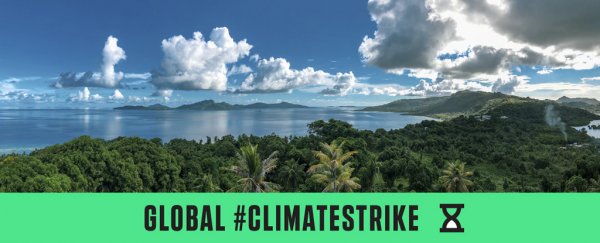Pacific islanders are running out of time. If global emissions are not drastically reduced, thousands of low-lying atolls may become uninhabitable within decades. And the biggest threat doesn't actually come from losing land to rising seas.
Small island states in the Pacific are responsible for only 0.03 percent of the world's carbon dioxide emissions, and yet the millions of people who live here are experiencing some of the earliest and most severe consequences. For them, climate change is an undeniable existential threat to their homeland, their culture, and their livelihoods.
The image of a sinking island has become a potent symbol for climate change in the tropics, and as sea levels rise faster here than anywhere else in the word, most research predicts these low-lying islands will be submerged by the end of the century.
But there are other threats that could come a whole lot sooner. Initial research suggests that as sea levels rise, some islands might run out of freshwater long before they run out of land.
Even now, on most developing islands in the Pacific, freshwater is already an imperilled resource. On many populated atolls, the primary source is rain that's soaked into the soil and collected as groundwater.
Yet as sea levels continue to rise and flooding becomes more frequent, the ground on these islands might also begin to absorb seawater. And if subsequent rainfall doesn't flush all that salt out of the island's aquifer, it will likely become contaminated.
This disaster scenario could deprive entire isolated islands of their sole source of drinking water, forcing residents to rely on rainfall and shipments alone.
"While the popular press has focused on the threat of inundation of island coastal areas by rising sea levels, perhaps the most critical near- and long-term threat to these nations is the possible impacts of climate change on freshwater quality and availability," reads a paper from 2002.
Last month, a group of Pacific island nations - including Fiji, Kiribati, Nauru, Micronesia, the Marshall Islands, the Solomon Islands, Vanuatu, Timor Leste and Tonga - came together to declare their situation a climate crisis and demand major emitters around the world do something about it. As early as 2030, they say, their lands could become uninhabitable.
That's really soon. While a Pentagon-commissioned report from 2018 suggests that's a real possibility, it's also a worst-case scenario. A more optimistic prediction from the same research suggests such dire circumstances will arrive mid-century.
Either way, it means that many children growing up in the Pacific today will live to see a time when their homeland can no longer sustain them.
"As much as possible, we must try to adapt and mitigate in situ because that's where people have their homes, land and livelihoods," said ActionAid global climate change lead Harjeet Singh at a recent United Nations climate event in Bangkok.
"But more places are becoming uninhabitable because of land degradation, rising sea levels or other weather impacts, and there is no choice but to relocate."
The threat to Pacific islander freshwater supplies has also been neglected in research. To date, very few studies have examined how sea level rise and wave action drive flooding on Pacific islands, or how this flooding might affect freshwater supplies.
Last year's Pentagon-commissioned report is one of the few of its kind. Based on current emissions and mid-range scenarios, it suggests that most atolls in the Pacific will be uninhabitable by the mid-century.
The loss of these lands, the authors argue, will ultimately come from sea-level rise, exacerbated by frequent wave-driven flooding. Not only will this dangerous combo deliver repetitive damage to rainfall collection systems, they say, it will also stop groundwater aquifers from fully recovering.
"Island inhabitants will therefore be unable to rely on groundwater, in many cases the sole source of fresh water, as a source of potable water in the next few decades," the authors conclude, "and thus, the islands will be uninhabitable by the middle of the 21st century - not by the end of the 21st century or the middle of the 22nd century as previously suggested."
Hilda Heine, the president of the Marshall Islands, told The Washington Post last year that this paper "brings home the seriousness" of her island nation's future. "It's a scary scenario for us," she said.
But there's still time to adapt and act. Earlier this month, at the UN Climate Change gathering in Bangkok, climate experts said small islands and coastal cities in the Asia-Pacific need more funds to assist their vulnerable communities to either relocate or stay and defend.
If the world doesn't come together and adequately prepare for these changes, thousands of islands could soon be uninhabitable and many more people will find themselves displaced.
"We don't have the luxury of more land or mountains to move to," said Angeline Heine, the national energy planner in the Marshall Islands, at the UN climate talks.
"We are just focused on our survival, and wondering whether we will still be here 30 to 40 years from now."
This article is part of ScienceAlert's special climate edition, published in support of the global #ClimateStrike on 20 September 2019.

